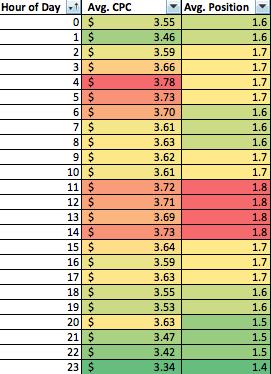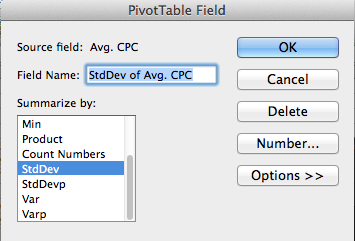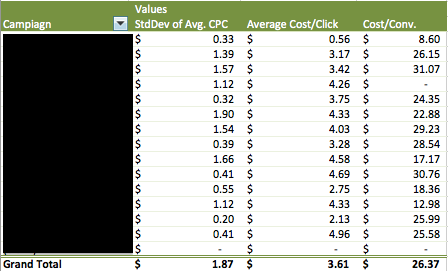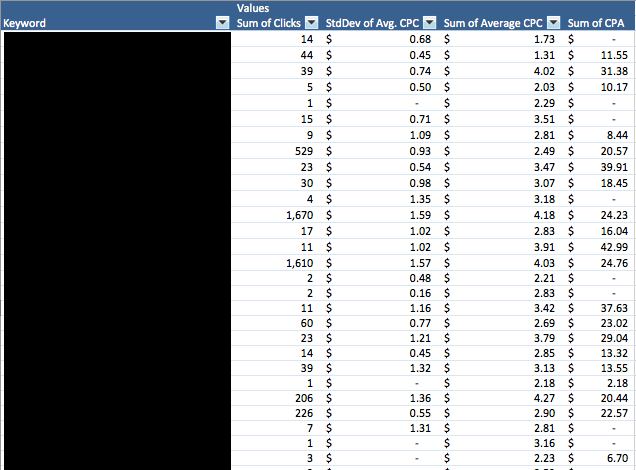How Your Average CPC is Lying to You

“Averages lie.” I had a few statistics courses back in college with a professor who was fond of saying that. Seems like he might’ve gotten that turn of phrase from someone else, now that I think about it.
This is problematic for us– as PPC professionals, we work with averages on a daily basis. No average has a larger impact on your bottom line than the average cost you’re paying for every single click. As we look in to account metrics for this week’s series, I wanted to dive in to what that average actually means in relation to your bid– and why it’s lying to you.
To answer that, let’s start with a simple analysis:

Over the last 90 days in the Search campaigns for this particular account, the bids have been set at an average of $4.98. The average cost per click in this same time frame is over 21% lower at $3.93 in Search, and even lower at $3.61 if we include Display. If we’re paying so much less for each click, does it make sense to bid so much more? Shouldn’t they be closer in line with one another?
Not necessarily.
At any given time, your average cost per click can vary wildly – due to time of day, day of the week, location, device, and most importantly, due to competition. For instance, in this same account, the average cost per click can vary by a significant amount just due to time of day alone:

Unsurprisingly, there’s a correlation here between the rise of our average cost per click and a rise in average position: we’re seeing more competitors enter the auction, and doing so more aggressively at those specific hours of the day. If we make the mistake of setting our Max. CPC bid too close to our average, we’d then run the risk of losing out on the most competitive (and most valuable) search auctions of that day.
On a side note: this is why, in my experience, the estimated “First Page” and “Top of Page” bid recommendations are fairly useless. They can’t account for the variance inherent in the real-time SERP auction.
There’s an easy way for you to measure the volatility of your own CPC’s, though– and that’s by measuring the standard deviation of your Average CPC. The standard deviation shows us how much variation or dispersion from the average exists. In this case, it will give us a pretty good idea of how much our CPC can fluctuate (in dollars and cents), and can also inform us of opportunities for bid readjustment.
How can we do this? It all starts with memorizing this simple formula:

…Just kidding. We can actually use Excel for this, either in formula form using =STDEV, or with the almighty Pivot Table.
If you want to follow along, then do this:
- Download an AdWords report with any segment– by day, time of day, day of week, whatever you want. For this next example, I’ve downloaded a campaign report from the last 90 days segmented by day.
- Create a Pivot Table off of that data. In my report, I’m going to be examining our Average CPC standard deviation by campaign and day, so I’ve set it up with “Campaign” in the Row Labels field, and “Avg. CPC” as my value.
- Where you would traditionally change the “Count of” or “Sum of” field name, you can scroll down to find “StdDev”. That’s what we’re looking for here.

Now we’re left with a Pivot Table that should look something like this:

I added a few calculated fields in for flair– our campaign average CPC and cost per conversion in this case. It’ll help to give us context to the metrics we’re seeing above.
Over the last 90 days, some campaigns have seen a wide variance in their average CPC, while others have not– even though some have a very high average CPC as it is. This tells us that some campaigns, like the one with an Avg. CPC of $4.69 and a standard deviation of $.40, are more competitive terms being limited by their Max. CPC. Lowering our bids in that campaign would likely have the impact of making us less competitive in our peak hours, since we already have so little leeway as-is.
Other campaigns, especially those with a high standard deviation and are also above our CPA goal of $27.50 are prime candidates for readjustment. By lowering our Max. CPC bids there, we can regain some control over our CPC and lower our CPA. Now, you might be thinking: “Lowering bids on high-CPA keywords? No duh.” But this can give you a better idea of how much room you have to operate.
You can also do the same analysis with a search term report to get an idea of your CPC’s volatility at the keyword & query level:

As well as by match type:

Unsurprisingly, the match types where we have less control have a higher variance in their average click costs.
So averages lie, and the average CPC metric is no different. The real point I’m trying to make is this: when it comes to the relationship of your average CPC, it’s standard deviation and your bid – you have control over the top end of your average CPC, but your competitors have control over the bottom end.
Keep that in mind as you look at your average CPC vs. your bid, and don’t freak out (too much) if they’re far apart.



